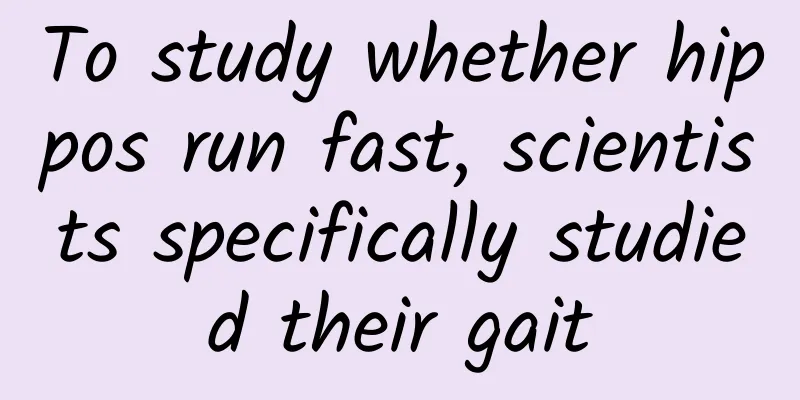To study whether hippos run fast, scientists specifically studied their gait

|
Produced by: Science Popularization China Author: Su Chengyu (popular science creator) Producer: China Science Expo Editor's note: In order to decode the latest mysteries of life science, the China Science Popularization Frontier Science Project has launched a series of articles called "New Knowledge of Life" to interpret life phenomena and reveal biological mysteries from a unique perspective. Let us delve into the world of life and explore infinite possibilities. In June 2024, British scientists published a paper in the journal PeerJ, revealing the unique locomotion ability of hippos (Hippopotamus amphibius) on land. When many scientific media cited this article, the headlines emphasized that hippos can soar into the air when running. Hippo running (Image credit: Sabine Stols) When you look at this kind of headline, your first reaction is that hippos must run very fast to do this, but the truth is not that simple. To understand why, you have to first understand how scientists do research. Kate M. Baker is an experienced animal behaviorist who is passionate about studying the movement patterns of large mammals. Victoria Fishlock and Eleanor Slade, who work with her, are experts in ecology and conservation biology. Stephen J. Wickings is a skilled data analyst who has a unique talent for processing and interpreting complex video data. They conducted a detailed study in North York, England, where scientists filmed 16 hours of hippo videos, recording every movement of the hippopotamus as it walked from the water to its habitat. But that wasn't enough, so for a more comprehensive analysis, scientists also collected more videos of hippo gaits from platforms such as YouTube to ensure the diversity and comprehensiveness of the data. Example of gait pattern in hippopotamus movement data analysis (Image source: Document 1) They then converted the videos into frame-by-frame images and used VirtualDub software to analyze the timing of each foot landing and leaving the ground, frame by frame. This is an extremely detailed task because the analysis of each frame may lead to new discoveries. The results showed that hippos mainly trotted at all speeds. At their highest speed, hippos' stride frequency reached 3.2 times per second, and their stride length exceeded 2 meters. When they ran at their fastest speed, all four legs would leave the ground at the same time, and there was a brief airborne phase. The airborne time (the time when all four limbs were off the ground at the same time) was about 15%. The hippopotamus is in mid-air, with none of its limbs touching the ground (Image source: Document 1) How do scientists know that hippos use a trotting gait? What is a trotting gait? For terrestrial mammals, no matter how they walk or run, they mainly have the following gaits: walking gait, trotting gait, cantering gait, running gait, jumping gait, sideways gait, and waddling gait. In simple terms, in a walking gait, each foot touches the ground at different times, usually alternating between left forelimb, right hindlimb, right forelimb, and left hindlimb. The walking gait provides the greatest stability because there are always three feet touching the ground at any given time. Walking gaitBlue dot: left forelimbRed dot: right forelimbGreen dot: left hindlimbRed inverted trapezoid: right hindlimb (Image source: crowspath) The trot is a diagonal gait, that is, two diagonal feet, such as the left front leg and the right hind leg, touch the ground at the same time, followed by the other two diagonal feet (the right front leg and the left hind leg). This gait strikes a balance between speed and stability and is suitable for moving at medium speeds. Jogging gait (Image source: crowspath) The canter gait is a faster form of locomotion that typically involves phased movement of the front and hind limbs, with an airborne phase. This gait is suited to high-speed locomotion, often used to escape threats or move quickly. (Image source: crowspath) An animal may have several gaits, such as a dog walking at a leisurely pace, trotting at a faster pace, cantering and running at a faster pace. Of course, it is not ruled out that the dog may choose to jump when it is happy. The same is true for cats. Different gait patterns in dogs (Photo credit: The Canine Fitness Centre) Animals that can have multiple gaits are usually small, flexible, and able to adapt to different gait patterns to cope with different environments and needs. These animals need different movement abilities for hunting, escaping predators, and social interactions. And they have some specific advantages in physiological structure and anatomy, such as flexible joint structure, a relatively large proportion of legs to body length, strong cardiopulmonary function, etc. The first two have a greater impact, the more flexible joints can allow a larger range of limb movement, and the dog's shoulder and hip joints are highly flexible, enabling them to turn and change gait quickly. Legs are a large proportion of body length, or simply leg length. Animals with long legs usually have a longer stride, which means they can cover longer distances when running at high speeds. Dog in running state (Image source: thepackinmethodcc) Some animals have a limited number of gait patterns due to their body structure, and some animals may only use one gait throughout their lives. For example, our protagonist, the hippopotamus, mainly trots, all because of its short legs (relative to its body length). The common hippopotamus is the fifth largest land mammal on Earth, with adult hippos typically weighing between 1,500 and 3,800 kg. Such a huge size puts great pressure on its bones and joints, which limits its ability to adopt a variety of gait patterns. (Photo source: charm hathan) In addition, the hippopotamus's limbs are relatively short and strong, which provides them with strong support, but also limits their ability to move quickly. Generally speaking, the average leg length of an adult common hippopotamus is 1.7 meters (from shoulder joint to toe) and the average body length is 4 meters. Then the hippopotamus's leg length accounts for 42.5% of its body length. Compared with the beagle, which has multiple gaits, its average leg length is 57 cm and its average body length is 70 cm, which means that the beagle's leg length accounts for 81.4% of its body length, which is obviously much larger than the hippopotamus' leg length. Some people may say that this is unfair, because the two animals are too different. Let's take the rhinoceros, which are also found in Africa and are about the same size. For example, the white rhino (Ceratotherium simum) has an average leg length of 2 meters and an average body length of 3.8 meters. So, the leg length of the white rhino accounts for 52.6% of its body length, which is a larger percentage than the leg length of the hippopotamus. White Rhino (Image source: Wikipedia) This difference makes rhinos have one more gait pattern than hippos. According to research, rhinos have two main gait patterns on land: walking gait and running gait. In the paper, scientists also used observed data to prove that hippos will trot at any speed. In animal gait analysis, the stance phase and swing phase are two key cycles that describe the different stages of the limbs in a complete gait cycle. The stance phase is the part of the gait cycle during which the animal's feet touch the ground, supporting and propelling the body forward. The swing phase is another part of the gait cycle during which the animal's feet leave the ground and swing forward in preparation for the next contact with the ground. A complete gait cycle includes a stance phase and a swing phase. In gait analysis, the duty factor (DF) is usually used to describe the proportion of the stance phase in the entire gait cycle: the calculation formula is DF = stance phase time / gait cycle time. When the DF value is significantly greater than 0.5, it indicates a walking gait; when the DF value is significantly less than 0.5, it indicates a running gait; if it fluctuates between 0.5, it indicates a jogging gait. Most of the data points for hippos show that their DF values are close to or slightly below 0.5, indicating that their primary gait is trotting. Although hippos cannot increase their stride length over a large range to increase their speed, they can increase their stride frequency (from 0.17Hz to 3.2Hz) to increase their speed. But no matter what, there is still an upper limit to trotting. The trotting speed of a hippopotamus on land is about 30 kilometers per hour, and this speed can only be maintained for a short time. The white rhino, which can run, can run at a speed of 55 kilometers per hour in a short distance (this speed can only be maintained for a short time). So no matter what, at a similar weight, long legs are more flexible than short legs, and running is still faster than trotting. This also shows that there is no necessary connection between flying and running. Trotting can also fly, but it requires a higher speed. Although no one has specifically studied the time a rhino spends in the air while running, based on the definition of the running gait pattern and the trotting pattern (DF value), it is certain that its time in the air is definitely longer than that of a hippopotamus. It is not as good as the big hippopotamus, but it is better than the big hippopotamus. Elephants that are bigger than it will never be in the air at any speed because they are too heavy and their limbs need to keep contact with the ground to support their bodies. In any case, 15% of the time in the air is still not easy for the big hippopotamus, who calls it a short leg length. References: 1.Hutchinson JR, Pringle E V. Footfall patterns and stride parameters of Common hippopotamus (Hippopotamus amphibius) on land[J]. PeerJ, 2024, 12: e17675. 2.Ren L, Hutchinson J R. The three-dimensional locomotor dynamics of African (Loxodonta africana) and Asian (Elephas maximus) elephants reveal a smooth gait transition at moderate speed[J]. Journal of the Royal Society Interface, 2008, 5(19): 195-211. 3.Inuzuka N. Preliminary study on kinematic gait analysis in mammals[J]. Mammal Study, 1996, 21(1): 43-57. 4.Panagiotopoulou O, Pataky TC, Hutchinson J R. Foot pressure distribution in White Rhinoceroses (Ceratotherium simum) during walking[J]. PeerJ, 2019, 7: e6881. |
<<: Plastic bags can also be thrown into the recycling bin. Is that city friendly?
Recommend
Are the “edited” vegetables delicious?
The cover image is a copyrighted image. Reprintin...
How to fully plan a screen-sweeping event?
“Behind every successful case, there is a methodo...
Writing a small and simple activity post includes at least these twenty steps!
In the operation work, no matter it is user opera...
Some Misunderstandings about MVC/MVP/MVVM
Using MVP and MVVM patterns in Android developmen...
How important is a perky butt to athletes? There are so many benefits to having a strong butt!
Ask a Question! What impressed you most about the...
To B & To C: Are the operations of To B products really different?
Common concepts of To B operations and To C opera...
Summary and comparison of the three major free new media channels for increasing APP downloads!
The ultimate goal of new media for APPs is to dri...
IEA: Developing a definition of hydrogen based on emissions intensity
The IEA has published the report “Towards a defin...
How much does it cost to join the Changde Building Materials Mini Program? What is the price for joining the Changde Building Materials Mini Program?
How much does it cost to join the Changde Buildin...
The archaeological work of the South China Sea shipwreck has officially started, revealing the other side of underwater archaeology
Chinese ancestors have a long history of using ri...
If the United States takes a historical reversal and cancels its electric vehicle policy, what will happen to China's new energy vehicles?
About two years ago, the global automotive indust...
World Wildlife Day丨Is the zebra black with white stripes or white with black stripes?
Today (March 3) is World Wildlife Day. Wildlife i...
How much does it cost to be an agent of Beijing’s catering mini program? What is the price for being an agent for the Beijing catering mini program?
Why should you be an agent for WeChat Mini Progra...
The Earth's "two-faced" inner core rotates faster than the surface
What causes the differential rotation of the Eart...
Alibaba and Tencent have joined forces to "kill" an industry. People should have a better way to pay
[[341666]] This article is reprinted from the WeC...






![Kotlin has become the new darling of Android after waking up [with code]](/upload/images/67ebd9aa1a69b.webp)


